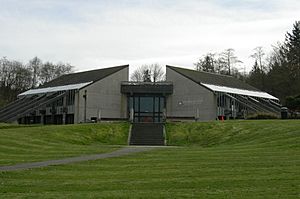Johnpaul Jones facts for kids
Johnpaul Jones, born on July 24, 1941, is a famous American architect and landscape architect. He is a partner at the firm Jones & Jones Architects and Landscape Architects in Seattle. He is well-known for designing amazing zoo exhibits that make visitors feel like they are right inside the animals' natural homes. Johnpaul Jones is also Native American and has worked on many projects for Native American groups. He was the main design expert for the National Museum of the American Indian in Washington, D.C., which opened in 2004. He was the first architect ever to receive the National Humanities Medal.
Contents
Becoming an Architect
Johnpaul Jones was born in Okmulgee, Oklahoma. His father was Welsh-American, and his mother was Choctaw and Cherokee. His maternal grandmother, Pearl, taught him about Native American traditions. When he was about 9 years old, he moved with his mother to California. They moved as part of a program for Native Americans. In California, he lived in a mostly Hispanic area and sometimes worked on farms with his mother.
Even though he struggled in school, he was very good at art and sports. He finished high school in 1959. He then went to San Jose City College. He got a job as an office helper at an architecture firm called Higgins & Root. His drawing skills helped him a lot. With help from his boss, he went to the University of Oregon. There, he became a serious student and became very interested in Native American architecture.
After college in 1967, he moved to Seattle. He worked for a few other firms before starting his own practice. He became more involved in Native American issues. In the early 1970s, he met Grant Richard Jones, a landscape architect. In 1973, Johnpaul joined Grant and his wife Ilze at their firm, Jones & Jones, in Seattle.
Designing Amazing Places
At Jones & Jones, Johnpaul Jones has worked on many exciting projects. He is especially known for his work on zoo exhibits and projects related to Native American heritage.
Zoo Habitats
Johnpaul Jones has led the design of many zoo projects. He helps create "immersion exhibits." These exhibits make visitors feel like they are truly in the animals' natural homes. This design method helps people learn more about animals and their environments.
Some of his zoo projects include:
- Tiger River Trail at the San Diego Zoo
- Asian elephant house at Woodland Park Zoo in Seattle
- Polar bear habitat at Point Defiance Zoo in Tacoma, Washington
- Master plan for the Honolulu Zoo
- Plans and exhibits for the Arizona-Sonoran Desert Museum
- African Savannah master plan and exhibits at Perth Zoo in Australia
- Jake L. Mamon Gorilla Conservation Research Center at the Dallas Zoo
- Master plan for the National Zoo of Belize
Heritage and Visitor Centers
He has also designed many heritage and visitor centers. These places help people learn about history and nature.
Some of these projects are:
- Gene Coulon Beach Park in Renton, Washington
- Buildings at Newcastle Beach Park in Bellevue, Washington
- Southeast Alaska Discovery Center in Ketchikan, Alaska
- Sleeping Lady Mountain Retreat and Conference Center in Leavenworth, Washington
- Phase II of the Bainbridge Island Japanese American Exclusion Memorial in Bainbridge, Washington
Native American Projects
A very important part of Johnpaul Jones's work focuses on his Native American heritage. He has designed many buildings and centers for Native American communities.
Some of these projects include:
- Daybreak Star Cultural Center in Seattle's Discovery Park (Seattle)
- Longhouse Project at The Evergreen State College in Olympia, Washington
- The Agua Caliente Cultural Museum in Palm Springs, California
- The Aquinnah Cultural Center Master Plan for the Wampanoag Tribe of Gay Head
- The Colville Confederated Tribes Museum Master Plan in Colville, Washington
- The De'aht Tribal Elders Longhouse center for the Makah Indian Tribe
- The Southern Ute Museum and Cultural Center for the Southern Ute Indian Tribe
- The Spokane Tribal Cultural Center Master Plan for the Spokane Tribe
- The Tiwyekinwes Cultural Center Master Plan for the Chief Joseph Band of the Nez Perce Indians
- Institute of American Indian Arts in Santa Fe, New Mexico
- Intellectual House at the University of Washington in Seattle
- Santa Ynez Chumash Museum and Cultural Center for the Santa Ynez Band of Chumash Mission Indians
Johnpaul Jones also helped design the Vancouver Land Bridge in Vancouver, Washington. This bridge was part of the Confluence Project. It helps people walk from Fort Vancouver to the Columbia River waterfront. The bridge follows an old Native American path.
He was the main design expert for the Smithsonian Institution's National Museum of the American Indian. He said the museum "doesn't have a straight line in it." He explained that the design is very natural and focuses on four worlds: the natural world, the animal world, the human world, and the spirit world. These ideas helped shape the building, its location, and its inside spaces.
Helping Others in Architecture
Since the 1980s, Johnpaul Jones has worked to make the architecture and design fields more diverse. He helped start the AIA Seattle Diversity Roundtable. This group helps students learn about architecture and offers scholarships. He has also worked on similar programs at the University of Oregon. He is involved with groups like the American Indian Council of Architects and Engineers.
Personal Life
Johnpaul Jones married Hannah Stratton in 1965. They had two children, Sequoia and Ingrid. They divorced in 1990. He married Marjorie Sheldon on September 21, 1997.


